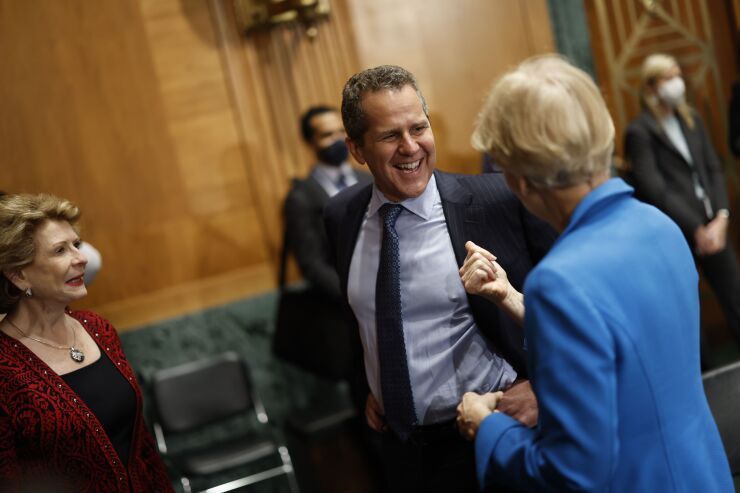
In what has become an annual tradition, banks and their advocates are crying foul over the Federal Reserve's stress testing regime.
Bank of America and Citi have both
Stress testing has become a
"The annual stress test is no longer a test that banks 'pass' or 'fail,'" Francisco Covas, head of research at BPI, said in a statement. "It no longer functions as a traditional supervisory exercise like the Supervisory Capital Assessment Program during the global financial crisis. Instead, since 2020, the hypothetical losses calculated for each bank are transformed into a capital charge that is added to each bank's minimum capital requirements."
This year's clash comes as the Fed conducts a
"It looks to me like capital requirements are, in fact, going to go up," David Zaring, a law professor at the University of Pennsylvania's Wharton School of Business, said. "I'm focused on how they are going to be extended to the midsize banks."
Fed Vice Chair for Supervision Michael Barr has said capital levels could
Within the so-called Basel III endgame, the only potential change to stress testing is how frequently banks are subjected to it, said Chen Xu, a lawyer with the firm Debevoise & Plimpton.
Currently, banks with more than $250 billion of assets must go through scenario testing every year. The results of these examinations dictate the stress capital buffers applied to each participating bank and determine how much of a dividend they can pay to investors. Banks with between $100 billion and $250 billion are typically tested on a two-year cycle. Previously, these different regimes were referred to as
Xu said he anticipates the yearly testing to expand to more banks in the $100 billion to $250 billion asset range.
"If what is being signaled is correct, they're going to replace the current advanced approaches with the new Basel standardized approach then expand the scope of that new advanced approach to a larger set of banks," he said. "It could mean the way that the Fed conducts stress tests doesn't change at all, because CCAR [Comprehensive Capital Analysis and Review] is based on the standardized approach."
By law, large banks with less than $250 billion of assets must be stress tested periodically. The two-year cycle was established through a Fed rulemaking process, meaning changing it to an annual test would
This year's test also included an exploratory market shock scenario, to which only the largest, global systemically important banks were subjected. While the results of this additional examination did not impact bank capital requirements, Derek Tang, co-founder of Monetary Policy Analytics, said it could be a sign of things to come.
"It clearly sets the stage for multiple scenarios in future stress tests," Tang said. "This time they said it's not binding … but they don't rule out that they could introduce more of these multiple scenarios or that these scenarios could weigh on capital requirements in the future."
The 23 large banks put through this year's scenario test all had enough capital to withstand a severe economic downturn that resulted in $540 billion of losses. Overall, banks saw their common equity tier 1 capital ratios fall by less in this year's test than in the 2022 version, meaning stress capital buffers across the industry are set to decrease for next year.
Some banks did perform slightly worse year over year, including Citi, which is set to see its stress capital buffer increase from 4% to 4.3%, according to a release from the New York-based bank. Citi has contested the findings, saying that it expected its noninterest income during the nine-month examination period to be $64.4 billion instead of the Fed's $43.9 billion projection.
It is not unusual for banks to question why their stress test results differ from internal projections. The Fed has a process for making factual inquiries or supplying additional information that may have been inadvertently omitted, but the central bank has yet to change a bank's marks as a result.
On Friday, BPI released a paper highlighting several issues with the stress, including "excessive volatility" both between banks and from one year to the next. It also noted that modeling changes around pre-provision net revenue places too much emphasis on past performance and that the Fed's methods for projecting unrealized losses and gains are more sensitive than those used by banks. Without knowing the specifics of how the Fed's forecasts are made, banks are unable to adjust their balance sheets accordingly, Covas and Jose Maria Tapia, the paper's authors, argue.
"The Federal Reserve needs to be significantly more transparent about how it projects stress losses and revenues for banks," they wrote. "This transparency enables banks to make informed and efficient decisions on their balance sheets and capital that consider supervisors' views of risks."
Others say the Fed has already taken strides to make the stress test more transparent and giving away too much more information would hurt the credibility of the examination — something that would diminish the standing of both the Fed and the banks.
Zaring said banks are justified in being frustrated by the fact that a binding capital constraint — the stress capital buffer — is established on a firm-by-firm basis rather than in a uniform manner. But, he noted, the process as it stands works to their advantage, both by forcing them to prepare for adverse scenarios and giving them a bill of good health to share with potential customers and investors.
"It's not the most efficient way to increase the amount of capital required by banks, but nothing in this world is perfect," Zaring said. "Banks get this marketing seal of approval upside out of it and, because banks should be engaged in risk scenario planning, the sweet is worth the bitter."






